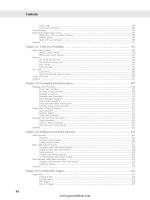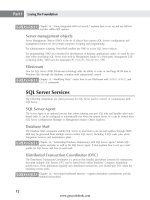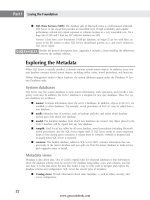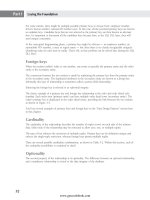Hướng dẫn học Microsoft SQL Server 2008 part 69 ppt
Bạn đang xem bản rút gọn của tài liệu. Xem và tải ngay bản đầy đủ của tài liệu tại đây (576.17 KB, 10 trang )
Nielsen c26.tex V4 - 07/23/2009 4:56pm Page 642
Part IV Developing with SQL Server
END AS status
FROM sys.triggers Tr
JOIN sys.objects Ob
ON Tr.parent_id = Ob.object_id
JOIN sys.schemas Sc
ON Ob.schema_id = Sc.schema_id
WHERE Tr.Type = ‘TR’ and Tr.parent_class = 1
ORDER BY Sc.name + ‘.’ + Ob.name, Tr.Name
Result:
table trigger type status
HumanResources.Employee dEmployee instead of enabled
Person.Person iuPerson after enabled
Production.WorkOrder iWorkOrder after enabled
Production.WorkOrder uWorkOrder after enabled
Purchasing.PurchaseOrderDetail iPurchaseOrderDetail after enabled
Purchasing.PurchaseOrderDetail uPurchaseOrderDetail after enabled
Purchasing.PurchaseOrderHeader uPurchaseOrderHeader after enabled
Purchasing.Vendor dVendor instead of enabled
Sales.SalesOrderDetail iduSalesOrderDetail after enabled
Sales.SalesOrderHeader uSalesOrderHeader after enabled
Triggers and security
Only users who are members of the sysadmin fixed server role, or are in the dbowner or ddldmin
fixed database roles, or are the tables’ owners, have permission to create, alter, drop, enable, or disable
triggers.
Code within the trigger is executed assuming the security permissions of the owner of the trigger’s table.
Working with the Transaction
ADMLINSERT, UPDATE,orDELETE statement causes a trigger to fire. It’s important that the trigger
has access to the changes being caused by the DML statement so that it can test the changes or handle
the transaction. SQL Server provides four ways for code within the trigger to determine the effects of the
DML statement. The first two methods are the
update() and columns_updated() functions, which
may be used to determine which columns were potentially affected by the DML statement. The other
two methods use
deleted and inserted images, which contain the before and after data sets.
Determining the updated columns
SQL Server provides two methods for detecting which columns are being updated. The first is the
UPDATE() function, which returns true for a single column if that column is affected by the DML
transaction:
IF UPDATE(ColumnName)
642
www.getcoolebook.com
Nielsen c26.tex V4 - 07/23/2009 4:56pm Page 643
Creating DML Triggers 26
An INSERT affects all columns, and an UPDATE reports the column as affected if the DML statement
addresses the column. The following example demonstrates the
UPDATE() function:
ALTER TRIGGER dbo.TriggerOne ON dbo.Person
AFTER INSERT, UPDATE
AS
IF Update(LastName)
BEGIN;
PRINT ‘You might have modified the LastName column’;
END;
ELSE
BEGIN;
PRINT ‘The LastName column is untouched.’;
END;
With the trigger looking for changes to the LastName column, the following DML statement will test
the trigger:
UPDATE dbo.Person
SET LastName = ‘Johnson’
WHERE PersonID = 25;
Result:
You might have modified the LastName column
This function is generally used to execute data checks only when needed. There’s no reason to test the
validity of column A’s data if column A isn’t updated by the DML statement. However, the
UPDATE()
function will report the column as updated according to the DML statement alone, not the actual data.
Therefore, if the DML statement modifies the data from
‘abc’ to ‘abc’, then the UPDATE() will still
report it as updated.
The
columns_updated() function returns a bitmapped varbinary data type representation
of the columns updated (again, according to the DML statement). If the bit is
true, then the column is
updated. The result of
columns_updated() can be compared with integer or binary data by means of
any of the bitwise operators to determine whether a given column is updated.
The columns are represented by right-to-left bits within left-to-right bytes. A further complication is
that the size of the
varbinary data returned by columns_updated() depends on the number of
columns in the table.
The following function simulates the actual behavior of the
columns_updated() function. Passing the
column to be tested and the total number of columns in the table will return the column bitmask for
that column:
CREATE FUNCTION dbo.GenColUpdated
(@Col INT, @ColTotal INT)
RETURNS INT
AS
BEGIN;
643
www.getcoolebook.com
Nielsen c26.tex V4 - 07/23/2009 4:56pm Page 644
Part IV Developing with SQL Server
Copyright 2001 Paul Nielsen
This function simulates the Columns_Updated() behavior
DECLARE
@ColByte INT,
@ColTotalByte INT,
@ColBit INT;
Calculate Byte Positions
SET @ColTotalByte = 1 + ((@ColTotal-1) /8);
SET @ColByte = 1 + ((@Col-1)/8);
SET @ColBit = @Col - ((@ColByte-1) * 8);
RETURN Power(2, @ColBit + ((@ColTotalByte-@ColByte) * 8)-1);
END;
To use this function, perform a bitwise AND (&) between columns_updated() and
GenColUpdated().Ifthebitwiseand is equal to GenColUpdated(), then the column in
question is indeed updated:
If COLUMNS_UPDATED()& dbo.GenColUpdated(@ColCounter,@ColTotal) =
@ColUpdatedTemp
Inserted and deleted logical tables
SQL Server enables code within the trigger to access the effects of the transaction that caused the trigger
to fire. The
inserted and deleted logical tables are read-only images of the data. Think of them as
views to the transaction log.
The
deleted table contains the rows before the effects of the DML statement, and the inserted table
contains the rows after the effects of the DML statement, as shown in Table 26-2.
TABLE 26-2
Inserted and Deleted Tables
DML Statement Inserted Table Deleted Table
Insert Rows being inserted Empty
Update Rows in the database after the update Rows in the database before the update
Delete Empty Rows being deleted
The inserted and deleted tables have a limited scope. Stored procedures called by the trigger will
not see the
inserted or deleted tables. The SQL DML statement that originated the trigger can see
the
inserted and deleted triggers using the OUTPUT clause.
644
www.getcoolebook.com
Nielsen c26.tex V4 - 07/23/2009 4:56pm Page 645
Creating DML Triggers 26
For more details on the OUTPUT clause, refer to Chapter 15, ‘‘Modifying Data.’’
The following example uses the inserted table to report any new values for the LastName column:
ALTER TRIGGER TriggerOne ON Person
AFTER UPDATE
AS
SET NOCOUNT ON;
IF Update(LastName)
SELECT ‘You modified the LastName column to ’
+ Inserted.LastName;
FROM Inserted;
With TriggerOne implemented on the Person table, the following update will modify a LastName
value:
UPDATE Person
SET LastName = ‘Johnson’
WHERE PersonID = 32;
Result:
You modified the LastName column to Johnson
(1 row(s) affected)
Developing multi-row-enabled triggers
Many triggers I see in production are not written to handle the possibility of multiple-row INSERT,
UPDATE,orDELETE operations. They take a value from the inserted or deleted table and store it
in a local variable for data validation or processing. This technique checks only one of the rows affected
by the DML statement — a serious data integrity flaw. I’ve also seen databases that use cursors to step
through each affected row. This is the type of slow code that gives triggers a bad name.
Best Practice
B
ecause SQL is a set-oriented environment, every trigger must be written to handle DML statements
that affect multiple rows. The best way to deal with multiple rows is to work with the inserted and
deleted tables with set-oriented operations.
A join between the inserted table and the deleted or underlying table will return a complete set
of the rows affected by the DML statement. Table 26-3 lists the correct join combinations for creating
multi-row-enabled triggers.
645
www.getcoolebook.com
Nielsen c26.tex V4 - 07/23/2009 4:56pm Page 646
Part IV Developing with SQL Server
TABLE 26-3
Multi-Row-Enabled FROM Clauses
DML Type FROM Clause
Insert FROM Inserted
Update
FROM Inserted
INNER JOIN Deleted
ON Inserted.PK = Deleted.PK
Insert, Update
FROM Inserted
LEFT OUTER JOIN Deleted
ON Inserted.PK = Deleted.PK
Delete FROM Deleted
The following trigger sample alters TriggerOne to look at the inserted and deleted tables:
ALTER TRIGGER TriggerOne ON Person
AFTER UPDATE
AS
SELECT D.LastName + ‘ changed to ’ + I.LastName
FROM Inserted AS I
INNER JOIN Deleted AS D
ON I.PersonID = D.PersonID;
GO
UPDATE Person
SET LastName = ‘Carter’
WHERE LastName = ‘Johnson’;
Result:
Johnson changed to Carter
Johnson changed to Carter
(2 row(s) affected)
The following AFTER trigger, extracted from the Family sample database, enforces a rule that not only
must the
FatherID point to a valid person (that’s covered by the foreign key), the person must be
male:
CREATE TRIGGER Person_Parents
ON Person
AFTER INSERT, UPDATE
AS
646
www.getcoolebook.com
Nielsen c26.tex V4 - 07/23/2009 4:56pm Page 647
Creating DML Triggers 26
IF UPDATE(FatherID)
BEGIN;
Incorrect Father Gender
IF EXISTS(
SELECT *
FROM Person
INNER JOIN Inserted
ON Inserted.FatherID = Person.PersonID
WHERE Person.Gender = ‘F’);
BEGIN;
ROLLBACK;
RAISERROR(’Incorrect Gender for Father’,14,1);
RETURN;
END;
END;
Multiple-Trigger Interaction
Without a clear plan, a database that employs multiple triggers can quickly become disorganized and
extremely difficult to troubleshoot.
Trigger organization
In SQL Server 6.5, each trigger event could have only one trigger, and a trigger could apply only to one
trigger event. The coding style that was required to develop such limited triggers lingers on. However,
since version 7, SQL Server allows multiple
AFTER triggers per table event, and a trigger can apply to
more than one event. This enables more flexible development styles.
Having developed databases that include several hundred triggers, I recommend organizing triggers not
by table event, but by the trigger’s task, including the following:
■ Data validation
■ Complex business rules
■ Audit trail
■ Modified date
■ Complex security
To see a complete audit trail trigger, see Chapter 53, ‘‘Data Audit Triggers.’’
Nested triggers
Trigger nesting refers to whether a trigger that executes a DML statement will cause another trigger to
fire. For example, if the Nested Triggers server option is enabled, and a trigger updates
TableA,and
TableA also has a trigger, then any triggers on TableA will also fire, as demonstrated in Figure 26-2.
647
www.getcoolebook.com
Nielsen c26.tex V4 - 07/23/2009 4:56pm Page 648
Part IV Developing with SQL Server
FIGURE 26-2
The Nested Triggers configuration option enables a DML statement within a trigger to fire additional
triggers.
TableA TableB
Trigger2
Trigger1
DML
Nested Triggers
By default, the Nested Triggers option is enabled. Use the following configuration command to disable
trigger nesting:
EXEC sp_configure ‘Nested Triggers’, 0;
RECONFIGURE;
If the database is developed with extensive server-side code, then it’s likely that a DML will fire a trigger,
which will call a stored procedure, which will fire another trigger, and so on.
SQL Server triggers have a limit of 32 levels of recursion. Don’t blindly assume that nested triggers are
safe. Test the trigger’s nesting level by printing the
Trigger_NestLevel() value, so you know how
deep the triggers are nesting. When the limit is reached, SQL Server generates a fatal error.
Recursive triggers
A recursive trigger is a unique type of nested AFTER trigger. If a trigger executes a DML statement that
causes itself to fire, then it’s a recursive trigger (see Figure 26-3). If the database recursive triggers option
is off, then the recursive iteration of the trigger won’t fire. (Note that nested triggers is a server option,
whereas recursive triggers is a database option.)
A trigger is considered recursive only if it directly fires itself. If the trigger executes a stored procedure
that then updates the trigger’s table, then that is an indirect recursive call, which is not covered by the
recursive-trigger database option.
Recursive triggers are enabled with the
ALTER DATABASE command:
ALTER DATABASE DatabaseName SET RECURSIVE_TRIGGERS ON | OFF ;
Practically speaking, recursive triggers are very rare. I’ve needed to write a recursive trigger only for pro-
duction.
One example that involves recursion is a
ModifiedDate trigger. This trigger writes the current date
and time to the modified column for any row that’s updated. Using the
OBXKites sample database, this
script first adds a
Created and Modified column to the product table:
648
www.getcoolebook.com
Nielsen c26.tex V4 - 07/23/2009 4:56pm Page 649
Creating DML Triggers 26
USE OBXKites;
ALTER TABLE dbo.Product
ADD
Created SmallDateTime NOT NULL DEFAULT CURRENT_TIMESTAMP,
Modified SmallDateTime NOT NULL DEFAULT CURRENT_TIMESTAMP;
FIGURE 26-3
A recursive trigger is a self-referencing trigger — one that executes a DML statement that causes itself
to be fired again.
TableA
Trigger1
DML
Recursive Triggers
The issue is that if recursive triggers are enabled, then this trigger might become a runaway trigger.
Then, after 32 levels of recursion, it will error out.
The trigger in the following example prints the
Trigger_NestLevel() level. This is very helpful for
debugging nested or recursive triggers, but it should be removed when testing has finished. The second
if statement prevents the Created and Modified date from being directly updated by the user. If the
trigger is fired by a user, then the nest level is
1.
The first time the trigger is executed, the
UPDATE is executed. Any subsequent executions of the trig-
ger
RETURN because the trigger nest level is greater than 1. This prevents runaway recursion. Here’s the
trigger DDL code:
CREATE TRIGGER Products_ModifiedDate ON dbo.Product
AFTER UPDATE
AS
IF @@ROWCOUNT = 0
RETURN;
If Trigger_NestLevel() > 1
Return;
SET NOCOUNT ON;
PRINT TRIGGER_NESTLEVEL();
If (UPDATE(Created) or UPDATE(Modified))
649
www.getcoolebook.com
Nielsen c26.tex V4 - 07/23/2009 4:56pm Page 650
Part IV Developing with SQL Server
Begin;
Raiserror(’Update failed.’, 16, 1);
ROLLBACK;
Return;
End;
Update the Modified date
UPDATE Product
SET Modified = CURRENT_TIMESTAMP
WHERE EXISTS
(SELECT *
FROM Inserted AS i
WHERE i.ProductID = Product.ProductID);
To test the trigger, the next UPDATE command will cause the trigger to update the Modified column.
The
SELECT command returns the Created and Modified date and time:
UPDATE PRODUCT
SET [Name] = ‘Modified Trigger’
WHERE Code = ‘1002’;
SELECT Code, Created, Modified
FROM Product
WHERE Code = ‘1002’;
Result:
Code Created Modified
1002 2009-01-25 10:00:00.000 2009-06-25 12:02:31.234
Recursive triggers are required for replicated databases.
Instead of and after triggers
If a table has both an INSTEAD OF trigger and an AFTER trigger for the same event, then the following
sequence is possible:
1. The DML statement initiates a transaction.
2. The
INSTEAD OF trigger fires in place of the DML.
3. If the
INSTEAD OF trigger executes DML against the same table event, then the process
continues.
4. The
AFTER trigger fires.
650
www.getcoolebook.com
Nielsen c26.tex V4 - 07/23/2009 4:56pm Page 651
Creating DML Triggers 26
Multiple after triggers
If the same table event has multiple AFTER triggers, then they will all execute. The order of the triggers
is less important than it may at first seem.
Every trigger has the opportunity to
ROLLBACK the transaction. If the transaction is rolled back, then
all the work done by the initial transaction and all the triggers are rolled back. Any triggers that had not
yet fired won’t fire because the original DML is aborted by the
ROLLBACK.
Nevertheless, it is possible to designate an
AFTER trigger to fire first or last in the list of triggers. I
recommend doing this only if one trigger is likely to roll back the transaction and, for performance rea-
sons, you want that trigger to execute before other demanding triggers. Logically, however, the order of
the triggers has no effect.
The
sp_settriggerorder system stored procedure is used to assign the trigger order using the fol-
lowing syntax:
sp_settriggerorder
@triggername = ‘TriggerName’,
@order = ‘first’ or ‘last’ or ‘none’,
@stmttype = ‘INSERT’ or ‘UPDATE’ or ‘DELETE’
The effect of setting the trigger order is not cumulative. For example, setting TriggerOne to first
and then setting TriggerTwo to first does not place TriggerOne in second place. In this case,
TriggerOne returns to being unordered.
Transaction-Aggregation Handling
Triggers can maintain denormalized aggregate data.
A common example of this is an inventory system that records every individual transaction in an
InventoryTransaction table, calculates the inventory quantity on hand, and stores the calculated
quantity-on-hand in the
Inventory table for performance.
Index views are another excellent solution to consider for maintaining aggregate data.
They’re documented in Chapter 64, ‘‘Indexing Strategies.’’
To protect the integrity of the Inventory table, implement the following logic rules when using
triggers:
■ The quantity on hand in the
Inventory table should not be updatable by any process other
than the inventory transaction table triggers. Any attempt to directly update the
Inventory
table’s quantity should be recorded as a manual adjustment in the InventoryTransaction
table.
■ Inserts in the
InventoryTransaction table should write the current on-hand value to the
Inventory table.
■ The
InventoryTransaction table should not allow updates. If an error is inserted into the
InventoryTransaction table, an adjusting entry should be made to correct the error.
651
www.getcoolebook.com









